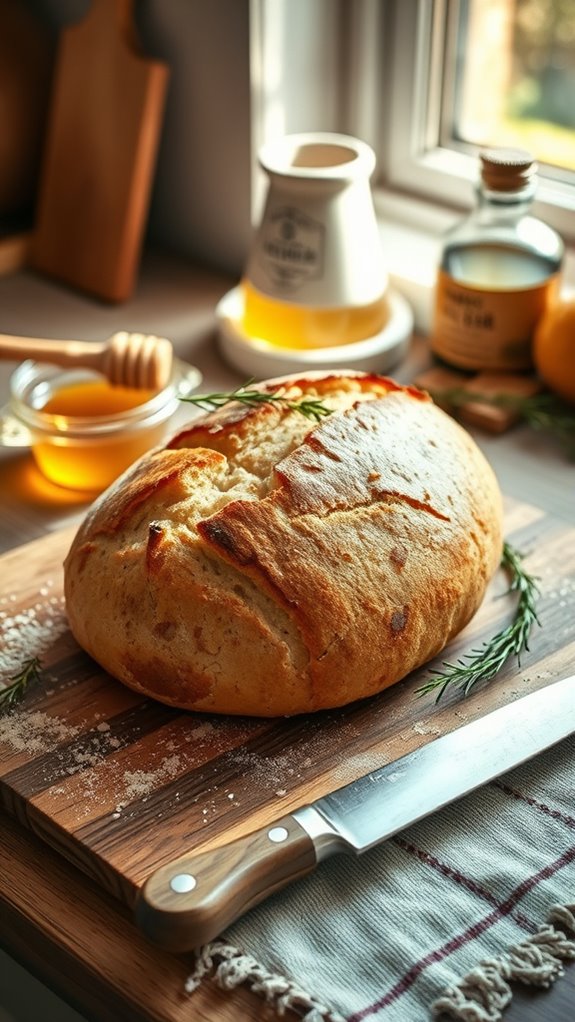Did you know that over 70% of people prefer homemade bread over store-bought options? Making your own whole grain bread not only gives you control over the ingredients but also allows you to enjoy the rich flavors and textures that come from a personal touch. With just a few simple ingredients and some patience, you can transform your kitchen into a haven of wholesome aromas and satisfying results. Let's explore how to create this delicious staple at home.
History
The history of homemade whole grain bread stretches back thousands of years, intertwining with the development of agricultural practices and the rise of civilizations.
As you explore this journey, you'll discover the essential role ancient grains played in shaping diets. Early communities learned to cultivate wheat, barley, and millet, adapting their techniques over generations.
This bread evolution mirrored societal changes, leading to diverse recipes in various cultures. By mixing different grains and experimenting with fermentation, they transformed simple ingredients into nutritious sustenance.
This age-old craft not only nourished people but also fostered community, becoming a staple in homes.
Today, as you bake your own whole grain bread, remember the rich history and traditions that influence your delicious creation.
Recipe

Making homemade whole grain bread isn't only a fulfilling experience but also allows you to enjoy the wholesome nutrition that whole grains provide. This bread is rich in flavor, texture, and nutrients, making it a great addition to any meal or perfect for sandwiches. With the right ingredients and a little patience, you can bake a delicious loaf that fills your home with the comforting aroma of freshly baked bread.
The process of creating this bread starts with mixing the whole grain flour, which is packed with fiber and crucial nutrients, with yeast and a few other simple ingredients. The dough's slow fermentation helps develop its unique flavor and makes it more digestible, delivering a hearty and satisfying result. Follow this recipe to bring a slice of wholesome goodness to your table.
Ingredients:
- 3 cups whole grain flour (such as whole wheat or spelt)
- 1 ½ teaspoons active dry yeast
- 1 ½ cups warm water (about 110°F)
- 2 tablespoons honey or maple syrup
- 1 teaspoon salt
- 2 tablespoons olive oil or melted butter
- Optional: seeds or nuts for added texture
Cooking instructions:
In a large mixing bowl, combine the warm water and honey (or maple syrup) and sprinkle the yeast over the top. Let it sit for about 5-10 minutes until it becomes frothy.
Next, add the whole grain flour, salt, and olive oil (or melted butter) to the mixture. Stir until a shaggy dough forms and then knead the dough on a floured surface for about 10 minutes until it's smooth and elastic.
Place the dough in a greased bowl, cover it with a damp cloth, and let it rise in a warm area for about 1 hour or until it doubles in size.
Once risen, punch down the dough, shape it into a loaf, and place it in a greased 9×5-inch loaf pan. Cover it again and let it rise for another 30-40 minutes.
Preheat your oven to 375°F and bake the loaf for 30-35 minutes, or until it sounds hollow when tapped on the bottom.
Extra tips: When baking whole grain bread, it's important to be patient during the rising times, as whole grain flour can take a bit longer to rise than white flour.
You can enhance the flavor by adding a tablespoon of vinegar or a tablespoon of gluten for a lighter texture. Additionally, using a bread stone in the oven can help achieve a nice crust.
For a more nutritious loaf, consider adding seeds or nuts, but be sure to adjust the flour measurement slightly to account for the extra ingredients. Enjoy your baking!
Nutritional Guide
While you savor the aroma of your freshly baked whole grain bread, consider its impressive nutritional profile that makes it a healthful choice for any diet.
Packed with fiber, this bread promotes healthy digestion and keeps you feeling full longer, reducing cravings. Whole grains are rich in essential nutrients like B vitamins, iron, and magnesium, contributing to your overall well-being.
If you want to add extra health benefits, try ingredient substitutions such as using honey for sweetness or incorporating seeds and nuts for added texture and nutrients.
Whether you're aiming for weight management or simply looking to enjoy a nutritious option, homemade whole grain bread is a delicious way to nourish your body while indulging your senses.
Final Thought
As you slice into that warm, homemade whole grain bread, it's easy to reflect on how this simple act can enrich your life in numerous ways. The aroma wafts through your kitchen, bringing comfort and a sense of achievement.
With a little practice and the right baking tips, you can master the art of bread-making, creating a healthy staple for your family. Don't hesitate to experiment with ingredient substitutions, such as swapping honey for sugar or using almond flour for added nutrition.
Each loaf tells your story, showcasing your personal flair while nourishing your loved ones. So, embrace the process, enjoy these rewarding experiences, and savor not just the bread, but the joy it brings to your home.
